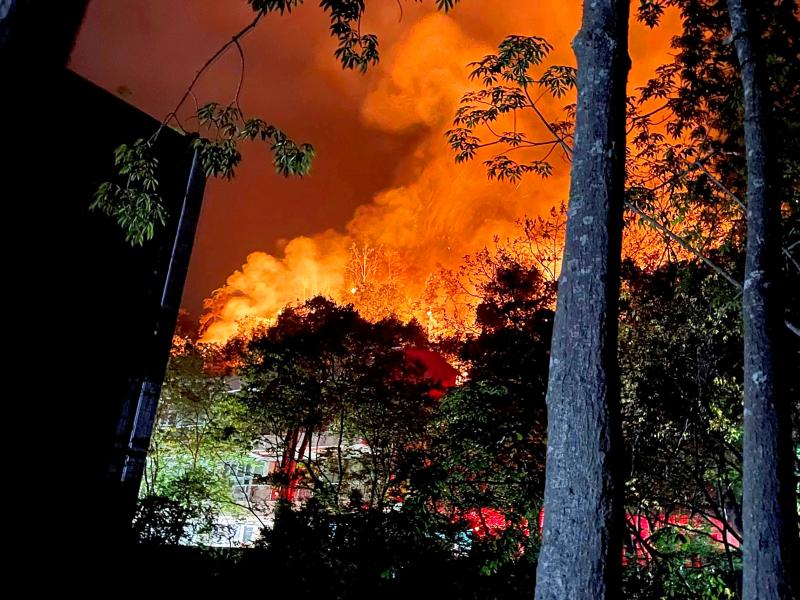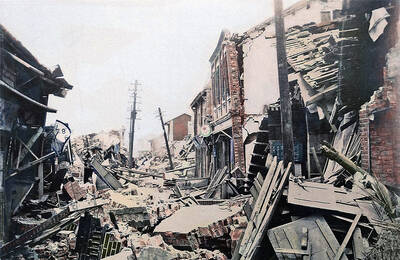Over the past few years, wildfires in several parts of the world have dominated the news.
The first six and a half months of this year saw almost 346,000 hectares of grassland, scrub and forest consumed by fire in Europe, three times the average between 2006 and last year, which was the worst ever for summer wildfires along Turkey’s Mediterranean coast.
The California wildfire seasons in 2020 and last year burned the highest and second-highest numbers of acres of land since recordkeeping began. So far this year, authorities in the US state have battled almost 4,700 wildfires.

Photo courtesy of Wang Chiu-shu
Given this alarming trend, it isn’t surprising that people in many parts of the world have begun to ask if climate change might be amplifying the problem of wildfires.
Taiwan isn’t prone to lowland fires in the way that Australia, California or countries adjacent to the Mediterranean are, but this doesn’t mean that wildfires aren’t a problem, or that changing weather patterns won’t exacerbate the frequency and severity of such calamities, says Lin Chau-chin (林朝欽).
Lin — who served as editor-in-chief of the Taiwan Journal of Forest Science and published extensively on the issue of forest fires during a long career at the Council of Agriculture’s Taiwan Forestry Research Institute (TFRI, 林業試驗所) — says that, due to Taiwan’s mountainous topography, the country has high-altitude forests that are similar to woodlands in temperate climate zone countries.

Photo courtesy of the Chiayi Forest District Office
FIRE ZONES
Around 1,500m to 2,500m above sea level, he says, conifers such as Taiwan red pine dominate the landscape.
“This means that Taiwan also has a fire zone, and that our forest fires are not very different in character to those in countries in temperate climate zones,” he says.

Photo courtesy of the Chiayi Forest District Office
Coniferous tree species burn especially well, because their leaves are easy to ignite when dry, and both the leaves and the wood are rich in oil.
This fire zone covers a considerable part of Taiwan. In fact, Lin points out, the percentage of Taiwan’s land that could be damaged by fire “is huge when compared to bigger countries, and this is why the government and the public should regard forest fires as true disasters.”
While scientists now see fire as part of the natural cycle of many ecosystems, large-scale forest fires are obviously undesirable. They release greenhouse gases that drive global warming. They can also heighten flood risk: Burned-out woodlands not only lack vegetation that can soak up immense quantities of water during and after downpours, but are also (due to soil chemistry) likely to have surfaces that don’t absorb water well and which are vulnerable to erosion.
Fires triggered by lightning strikes are relatively rare in Taiwan, Lin says. While the precise cause of many recorded wildfires can never be confirmed, he says they’re “mostly anthropogenic, seasonal and weather-dependent. Farming, smoking and hunting are the three main causes. Farming in mountain areas is a big social and land-use issue.”
Addressing the question of how climate change may influence fire risk in Taiwan’s woodlands, Lin points to data compiled by the Central Weather Bureau.
Annual average temperatures rose by 1.6 degrees Celsius between 1911 and 2020, and this has affected the length of the seasons.
“During the early 21st century, summer increased from 120 to 150 days, while winter shortened to about 70 days. In recent years, winter has shrunk further, to just 20 to 40 days,” he says.
Rainfall is the most significant single factor in the incidence of forest fire, Lin says. It goes without saying that the wetter a landscape is, the less likely it is to burn.
RAINFALL
There hasn’t been much change in total annual rainfall in Taiwan since 1911. Since 1961, however, the number of drier years has increased significantly compared with before 1960.
“The annual maximum number of consecutive days without rainfall — defined as rainfall of less than 1mm — has changed significantly, with an increase of about 5.3 days in a century. However, that trend has been in the past 30 years,” Lin says.
The rainfall data that Lin has examined shows fluctuations from year to year, but, he explains, “in the past 60 years, the gap between unusually wet years and unusually dry years has gradually increased, and the number of dry years is showing signs of increasing.”
Lin says that, to the best of his knowledge, no academic journal has published a paper which directly addresses the question of climate change impacting forest fire risk in Taiwan. However, the issue has drawn the attention of the Control Yuan.
In a report published on April 6, three members of the Control Yuan made several recommendations to the Forestry Bureau to enhance fire prevention and early warning systems and improve fire-fighting strategies. The report also pointed out that, since Lin retired from the TFRI in 2017, only one person at the institute has been researching wildfires.
For much of the postwar period, the main goal of forest management in Taiwan was timber production. Consequently, Lin says, the response to forest fires has been shaped by an approach that “totally ignores fire’s role on forest ecosystems. This causes forest ecosystem degradation and the accumulation of fuels.”
“Due to the influence of climate change, in recent years forest fires have become harder to put out,” Lin says. He names the Yushan National Park fire in May last year as an event that highlights the challenge Taiwan now faces.
Huge resources were thrown into combating the conflagration, but in the end it wasn’t put out by human effort. Instead, two days of heavy rain extinguished it.
“The 2021 fires make it obvious that forest-management authorities haven’t grasped the influence of climate change on fire management,” Lin says.
Lin agrees with the warnings and recommendations contained in “Spreading like Wildfire: The Rising Threat of Extraordinary Landscape Fires,” a report published in February by the United Nations Environment Program.
Saying that many governments around the world have wrongly focused on fire suppression at the expense of a more effective preventative approach, Lin endorses the report’s call for a “Fire Ready Formula.” Taiwan should, he says, “rebalance forestry investments with a focus on planning, prevention, preparedness and recovery.”
Steven Crook, the author or co-author of four books about Taiwan, has been following environmental issues since he arrived in the country in 1991. He drives a hybrid and carries his own chopsticks. The views expressed here are his own.

Last week Joseph Nye, the well-known China scholar, wrote on the Australian Strategic Policy Institute’s website about how war over Taiwan might be averted. He noted that years ago he was on a team that met with then-president Chen Shui-bian (陳水扁), “whose previous ‘unofficial’ visit to the US had caused a crisis in which China fired missiles into the sea and the US deployed carriers off the coast of Taiwan.” Yes, that’s right, mighty Chen caused that crisis all by himself. Neither the US nor the People’s Republic of China (PRC) exercised any agency. Nye then nostalgically invoked the comical specter

April 15 to April 21 Yang Kui (楊逵) was horrified as he drove past trucks, oxcarts and trolleys loaded with coffins on his way to Tuntzechiao (屯子腳), which he heard had been completely destroyed. The friend he came to check on was safe, but most residents were suffering in the town hit the hardest by the 7.1-magnitude Hsinchu-Taichung Earthquake on April 21, 1935. It remains the deadliest in Taiwan’s recorded history, claiming around 3,300 lives and injuring nearly 12,000. The disaster completely flattened roughly 18,000 houses and damaged countless more. The social activist and

Over the course of former President Ma Ying-jeou’s (馬英九) 11-day trip to China that included a meeting with Chinese Communist Party (CCP) leader Xi Jinping (習近平) a surprising number of people commented that the former president was now “irrelevant.” Upon reflection, it became apparent that these comments were coming from pro-Taiwan, pan-green supporters and they were expressing what they hoped was the case, rather than the reality. Ma’s ideology is so pro-China (read: deep blue) and controversial that many in his own Chinese Nationalist Party (KMT) hope he retires quickly, or at least refrains from speaking on some subjects. Regardless

Approaching her mid-30s, Xiong Yidan reckons that most of her friends are on to their second or even third babies. But Xiong has more than a dozen. There is Lucky, the street dog from Bangkok who jumped into a taxi with her and never left. There is Sophie and Ben, sibling geese, who honk from morning to night. Boop and Pan, both goats, are romantically involved. Dumpling the hedgehog enjoys a belly rub from time to time. The list goes on. Xiong nurtures her brood from her 8,000 square meter farm in Chiang Dao, a mountainous district in northern Thailand’s